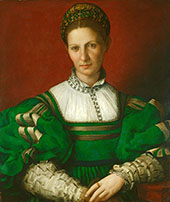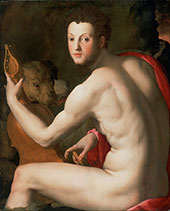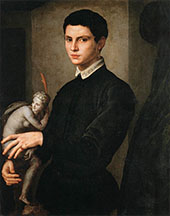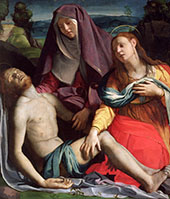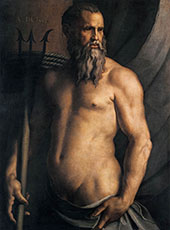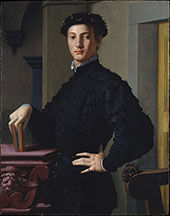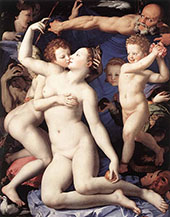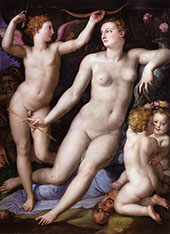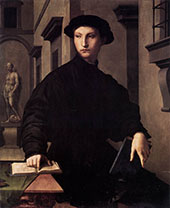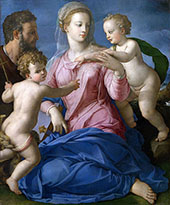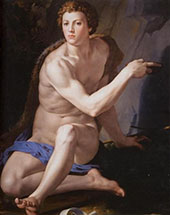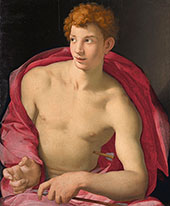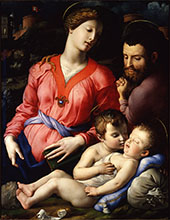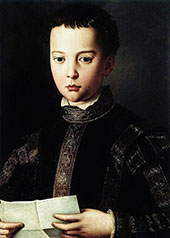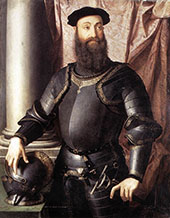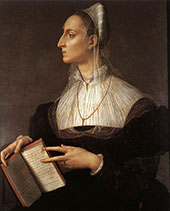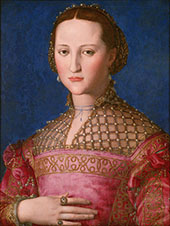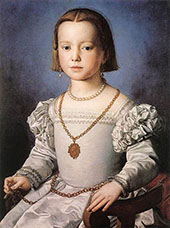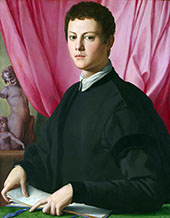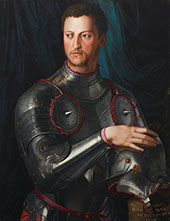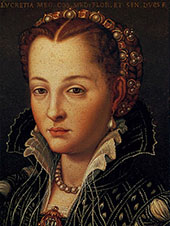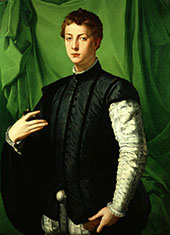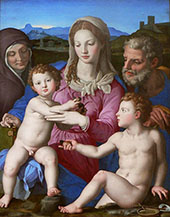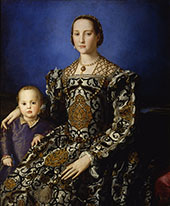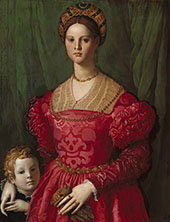Agnolo Bronzino Oil Painting Reproductions
Agnolo Bronzino replica paintings on Canvas for sale
Agnolo Bronzino: Renaissance Oil Paintings
Agnolo Bronzino is the creator of some of the most beautiful and famous Renaissance paintings and an undisputed master of the Italian Renaissance art movement. But who exactly was this pioneering artist, and what are some of the best-known Bronzino paintings?
This brief introduction presents Bronzino’s fascinating life, work, and times.
Where is Agnolo Bronzino from?
Born on 17 November 1503, Agnolo di Cosimo (Bronzino) hails from the Italian city of Florence. He spent almost all his working life in the city as a leading Florentine painter. Indeed, from his late thirties onwards, Bronzino worked almost exclusively for the Grand Duke of Tuscany (Cosimo I de Medici) as a court painter. Serving the Medicis occupied most of his professional time.
Bronzino mainly worked on Renaissance portrait paintings. These often consisted of portraits of the Medicis and were given by the family as diplomatic gifts. Agnolo Bronzino was an early pioneer of replica art and famous painting reproductions. The Grand Duke often ordered multiple copies of portrait paintings, which apprentice artists replicated for the family to hand out. Aside from his portraiture paintings, Bronzino created several famous Religious Paintings and allegorical topics. One of Bronzino’s best-known works is Venus, Cupid, Folly, and Time. Now held by the National Gallery in London, this painting depicts strong sexuality veiled by classical mythology.
While the meaning of the painting is uncertain, we know that Cosimo I de' Medici commissioned the work as a gift for King Francis I of France. The overt erotic sensuality of this oil painting appealed to Italian and French aristocratic tastes of the time. Its marble-like figures are set amongst luxurious yet vague backgrounds.
Who did Agnolo Bronzino study with?
Bronzino studied with Jacopo Carucci, known simply as Pontormo, an Italian Mannerist portraitist from the Florentine School. His artwork showed a significant shift away from the calmly controlled works of the early Florentine Renaissance. Instead, Pontormo’s paintings use ambiguous perspectives with characters floating in uncertain spaces. Bronzino’s painting style borrowed heavily from Pontormo’s teaching. Despite this, Bronzino returned a feeling of calm control to his stylish, elongated figures. Unlike his teacher, they rarely display any form of tension or dramatic emotion.
Scholars believe Pontormo included a portrait of a young fourteen-year-old Bronzino in his Joseph in Egypt painting. In it, Bronzino appears as a child seated on a step. The two men kept a close working relationship in adult life, often collaborating on their paintings. Indeed, their artistic styles are so similar that scholars still debate specific attributions. Bronzino also studied under Raffaellino del Garbo, a more classical Florentine Renaissance painter specializing in religious art and altarpieces.
What makes Bronzino's paintings Mannerist in style?
Mannerism is a 16th century art movement characterized by elegant figures and purposeful distortions. The art term applies to artists inspired by Raphael and Michelangelo, working between 1520 and 1600. Bronzino’s oil paintings perfectly fit this description, as the artist deeply admired these two Renaissance masters. Rather than studiously copying their strictly harmonized compositions, however, Bronzino, and other Mannerist art movement artists, went further. They displayed extreme skill and artistry by playing with natural compositions emphasizing sophisticated poses and elegant perspectives.
This careful staging appears in Bronzino's famous religious paintings, such as Saint Sebastian 1533 and St John the Baptist 1553. Both paintings feature significantly elongated limbs and torsos. These sensual male nude paintings also led some scholars to speculate Bronzino’s sexuality.
Why is Bronzino famous?
Bronzino is primarily known for his paintings of the Medici family. Amongst famous Renaissance oil paintings, however, his 1544 Portrait of Eleonora di Toledo col figlio Giovanni, the wife of Cosimo Medici, particularly shines. In this painting, the woman’s sumptuous dress is an expert depiction of fabric and form. Indeed, it takes up as much room as the two sitters who are placed against a sapphire-blue background. The young boy in the portrait was Eleonora’s second son, who sadly died from Malaria in 1562.
The Medici patronage started in 1539, and Bronzino created many elegant and assured family portraits. Replicated in many workshops and copies, Bronzino painted Cosimo, Eleonora, children, and friends with minute diligence. His celebrated portraits include works such as Portrait of Bia de Medici and Portrait of Cosimo I de Medici in Armor, both painted in 1545.
Did Bronzino produce Religious Paintings?
In addition to portraiture, Agnolo Bronzino also created several famous religious paintings. From 1540 onwards, he worked on frescos for the Chapel of Eleonora di Toledo, found in the Medici family’s Palazzo Vecchio in central Florence. This religious art comprises some of Bronzino’s finest paintings. The holy family is sensitively represented in the Madonna Panciatichi and Holy Family with St Anne and The Infant St John.
Later in life, Bronzino also helped found the “Accademia delle Arti del Disegno” in Florence. Cosimo I de Medici provided finance for an academy of artists, with further help from Giorgio Vasari. Bronzino was an active member, participating in the Academy and supervising artistic production throughout Tuscany. While most members were male, Artemisia Gentileschi was the first female artist admitted. Bronzino’s teaching at the Academy favored a gifted young artist named Alessandro Allori. Due to their friendship, Bronzino was often called Allori’s “uncle.” The two men enjoyed a close working and personal relationship, with Bronzino living at the Allori household for some time.
Why was Agnolo di Cosimo called Bronzino?
There is scarce evidence regarding Bronzino’s unusual nickname. However, many art historians speculate that it may refer to his reddish hair and dark skin tone. The Uffizi Gallery in Florence, specialists in Bronzino art, suggest it derives from the dark skin tones of his sitters. Examples include portraits such as Andrea Doria as Neptune 1550 and the somewhat gloomy portrait of Ugolino Martelli 1537. The Andrea Doria portrait is notable as a highly unusual allegorical work. Indeed, Renaissance portraits rarely placed such well-known public figures in imaginary mythological scenes. However, Bronzino also created another mythological portrait depicting Cosimo I de Medici as Orpheus (the Greek musician, poet, and prophet).
Where is Bronzino Buried?
Bronzino was staying with the Allori family at the time of his death in 1572. The cause of death is uncertain, but he rests at the Church of San Cristoforo degli Adimari in Florence. Just before his death on 22nd September 1607, Allori requested burial at the same church as Bronzino. Together, they were two of the last prominent Florentine old masters. Both artists have an undiluted Tuscan heritage stretching back to Fra Bartolomeo and Leonardo da Vinci. Andrea del Sarto worked in an unbroken chain alongside Bartolomeo and Da Vinci. Next, Sarto trained Pontormo, who taught Bronzino in turn. Finally, Bronzino tutored Allori, seen as one of the last great Mannerist Renaissance artists.
Agnolo Bronzino: Renaissance Oil Paintings
If you love the skillful mastery of Agnolo Bronzino oil paintings, explore our extensive collection of oil painting reproductions for sale.
Explore our extensive catalog of famous Renaissance oil paintings, Impressionism paintings, and Famous Nude Paintings. Discover the infinite beauty of replica paintings to enrich the walls of your home or office.
Cannot Find What You Are Looking For?
Reproduction Gallery Information
Customer Service
(Send Us A Message)
Tel: (503) 937 2010
Fax: (503) 937 2011


